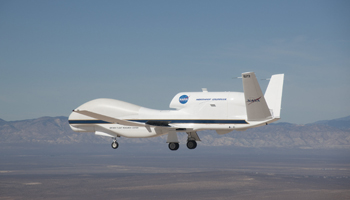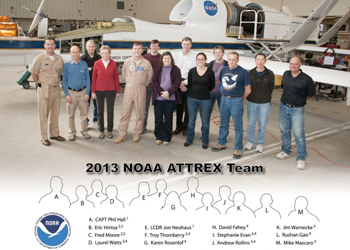2013 News & Events
Global Hawk measures stratospheric water vapor to help predict changes in climate
11 March 2013

NASA's Global Hawk UAS (unmanned aerial system) aircraft completes another series of flights as part of the Airborne Tropical TRopopause EXperiment (ATTREX). Piloted from the ground, the high-altitude long-range aircraft flies above the equatorial Pacific with a payload of scientific instruments, collecting data that will help researchers identify how changes in humidity in the upper atmosphere may affect climate.
Among the most influential greenhouse gases is water. In the troposphere low in the atmosphere, water's effect on climate is well understood. Water molecules absorb and re-release infrared radiation which causes an increase in temperature. As the climate warms, humidity increases, amplifying the greenhouse effect. In the stratosphere high in the atmosphere, water molecules also absorb and re-release infrared radiation. Stratospheric water vapor also contributes to ozone depletion. Scientists are particularly interested in whether global warming will trigger changes in stratospheric water vapor levels.
A primary goal of ATTREX is to better understand how water enters the stratosphere. The tropopause is the layer between the troposphere and the stratosphere. Air, including water vapor, moves into the stratosphere from the troposphere in the tropopause layer over the tropics. Above the equator, the tropopause occurs at an altitude of about 60,000 feet, and is reachable by the Global Hawk UAS operating from its home base at the NASA Dryden Flight Research Center in California.

The Global Hawk carries 12 scientific instruments in the ATTREX payload, including two from the NOAA research team, that measure meteorological parameters of temperature, pressure, and wind direction and speed, as well as water vapor, ozone, carbon dioxide, sulfur hexafluoride, bromine oxide, and various forms of radiation. Water vapor is particularly challenging to measure. The instrument developed by CSD researchers measures water vapor concentration to less than 1 ppm by monitoring an infrared absorption signal in a small cell with a flow of ambient air. The instrument is calibrated throughout a flight rather than only on the ground in order to account for changes in operating temperature and pressure in flight that could lead to measurement errors during flight.
The ATTREX project continues through 2015. After the remaining series of flights are completed in 2014, researchers will analyze data. A number of ACCP staff from CSD are participating in ATTREX. David Fahey is one of the lead platform scientists for aircraft flight planning and data analysis. Troy Thornberry and Andrew Rollins are principal investigators for the water vapor instrument and Ru-Shan Gao is the principal investigator for the ozone instrument. Laurel Watts, Steve Ciciora, and Richard McLaughlin provide technical support for the ACCP instrument suite.